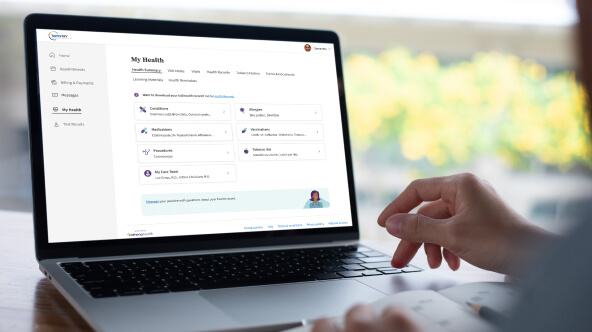How portable health data improves continuity, satisfaction, and loyalty
Patient portals have been the standard for giving people access to their medical records for years. But they’re built around a narrow assumption that patients receive most or all of their care from a single practice or health system.
That’s rarely the case. On average, people see 18 different providers over the course of their lives.1 And that number climbs quickly for anyone managing chronic conditions, caring for aging parents, or raising children. For example, one-third of older adults see at least five different doctors every year.2
Each encounter generates important data (labs, notes, medications), but it’s often siloed across disconnected systems. One patient might have records split between a local PCP, a cardiologist two counties over, a telehealth provider, and an urgent care clinic. Each with its own portal, only offering part of the health history.
That fragmentation isn’t just a data problem. It directly impacts the quality of care, and introduces risk — missed context, redundant testing, poor handoffs, and lower patient confidence.
Individual Access Services (IAS) offers a more scalable approach that reflects how patients actually move through today’s healthcare system.
Here we’ll discuss the promise of IAS, how it works, and what it means for patients and practices.
What is IAS? And how is it different from a portal?
IAS isn’t another portal, app, or health data network. It’s a set of national standards that make health data portable, defining how individuals can securely access their health records from multiple providers and systems, all in one place.
Here’s how it works: certified apps like personal health records (PHRs), wellness tools, or health tracking platforms use IAS standards to connect with national health information networks such as CommonWell and Carequality. These networks span thousands of organizations and enable true interoperability, allowing data to flow between systems that previously didn’t communicate.
Compare that to traditional patient portals, which only show information from a single provider’s electronic health record (EHR). IAS-enabled apps can help bring the full medical history together, no matter where care was delivered.
This access is supported by TEFCA™ (Trusted Exchange Framework and Common Agreement), a nationwide framework managed by the Office of the National Coordinator for Health IT (ONC). TEFCA sets the rules for secure data exchange, while Qualified Health Information Networks (QHINs) serve as the trusted intermediaries that make the technical connections work.
And behind all of this is the 21st Century Cures Act, a federal law that provides patients with stronger capabilities to access their electronic health information and cracks down on information blocking. It laid the foundation for interoperable, patient-directed access to health data, and IAS is how that vision is being realized.
So, when your EHR or patient engagement platform supports IAS, your patients can:
- View a unified, portable health record in one view
- Share data securely with digital tools they already use like wearable health trackers, wellness apps, or PHRs
- Access their data without managing logins for multiple portals (though the portal is still available)
- Maintain visibility into their care, even when they switch providers or health systems
- Benefit from care that’s informed by a full picture of their health, not just a single organization’s records
The bottom line is IAS doesn’t replace patient portals, it enhances them. By enabling secure, interoperable access across the healthcare system, IAS gives patients the visibility, control, and flexibility they need to stay connected to their care, wherever they go. And it does all this without creating extra complexity for providers.
RELATED CONTENT
Learn how athenahealth is among the first to operationalize TEFCA at scale.
Why Individual Access Services matter for both patients and practices
Digital experiences have reshaped expectations across industries, and healthcare is no exception. Today’s patients expect convenience, transparency, and personalized support. They often rely on technology not just to access care, but to understand it. They expect digital experiences that reduce friction, improve visibility, and help them manage their health on their own terms.
IAS supports this in a few important ways:
- Better continuity of care: When clinicians can see a patient's complete history, care becomes safer, more personalized, and more coordinated. This is especially critical for complex cases or transitions between care settings.
- Higher patient engagement: Visibility builds trust. When people can see and understand their own data, they’re more likely ask informed questions, follow through, and stay involved. That leads to better outcomes and stronger provider-patient relationships.
- Less administrative burden: Patients don’t have to call for records. Front-desk teams aren’t buried in faxes. And providers get the information they need, when they need it.
- Support for digital tools: Patients are turning to digital tools to support their health. IAS makes it easier for those tools to securely connect without extra effort from your team.
In short, IAS isn’t a regulatory checkbox or tech spec. It’s a patient-centered capability that affects how people experience your practice. Organizations that embrace it are better positioned to improve patient satisfaction, build trust, and strengthen continuity.
That matters because patients are actively choosing providers who offer better digital experiences. Research shows that 26% of patients are willing to switch to a new clinician for high-quality digital engagement services.3 In other words, technology makes a difference for convenience and whether a patient comes back.
IAS gives patients what they expect: simple, secure access to their complete health story.
What your technology needs to support
If IAS sounds complex, you're not wrong. But you don’t have to implement it yourself. You don’t need to become an expert in TEFCA or interoperability. What matters is that your EHR, engagement tools, and health IT partners are built for it — and they should handle the heavy lifting for you.
Here’s what capabilities to look for:
- Compliance with TEFCA interoperability requirements
- Support for standards-based data sharing through national networks like CommonWell
- Compatibility with PHR apps and other third-party tools patients already use
- Continued access via your existing patient portal, if patients prefer that route
IAS should feel like a seamless extension of your digital front door. The best systems make it invisible, working behind the scenes to enable smooth data access, so practices benefit from interoperability, not operational bloat.
Get IAS and TEFCA access with athenaOne®
At a time when patients are expecting more and providers are stretched thin, IAS offers a path to smarter, more connected care. It takes something as complex as health data exchange and turns it into something that just works.
athenahealth makes that connection simple. With athenaOne, practices enjoy an integrated platform that includes EHR, patient engagement, and practice management, improving efficiency and information flow within workflows and across our network of over 160,000 providers nationwide.
Through our partnership with CommonWell Health Alliance, one of the first designated QHINs under TEFCA, we support IAS capabilities. That means all eligible practices using athenaOne are already automatically connected. No extra integrations or IT work required.
Your patients can view and manage their complete health record using tools like the athenaPatient™ app and patient portal, without additional burden on your staff. This standards-based approach to interoperability supports clinical excellence, regulatory compliance, and long-term patient retention.
Better data access builds better care
The days of assuming patients will stay within one provider network are gone. People engage with healthcare the way they interact with everything else: across apps, platforms, and systems.
IAS gives you a scalable way to meet those expectations while supporting clinical quality, reducing admin burden, and building loyalty.
It’s not about replacing what works. It’s about extending what’s possible. And with the right technology partner, it doesn’t have to be complicated.
Want to learn how IAS fits into your strategy? Access practical resources to help you understand TEFCA and interoperability.
More patient engagement resources
Continue exploring
1 Fierce Healthcare, Apr. 2010, Survey: Patients see 18.7 different doctors on average. https://www.fiercehealthcare.com/healthcare/survey-patients-see-18-7-different-doctors-average
2 Norton, Amy, Nov. 2021, Almost 1 in 3 U.S. seniors now sees at least 5 doctors per year. Medical Xpress. https://medicalxpress.com/news/2021-11-outpatient-shifted-specialist-medicare-recipients.html
3 Accenture, Aug. 2020, How can leaders make recent digital health gains last?; https://www.accenture.com/us-en/insights/health/leaders-make-recent-digital-health-gains-last; IS050












